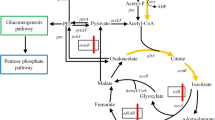Abstract
Carbon dioxide (CO2) emissions are related to global warming. However, CO2 can be used as an abundant and cheap carbon source for production of valuable chemicals using carbon capture and storage technology. Here, the genes related to carbon flux toward pyruvate biosynthesis in E. coli were deleted to enhance the incorporation of CO2 for succinate production. The codonoptimized carbonic anhydrase gene (SP(-)HCCA) derived from Hahella chejuensis KCTC 2396 and the phosphoenolpyruvate carboxylase gene (ppc) of E. coli W3110 were co-overexpressed to enhance carbon flux toward oxaloacetate synthesis in E. coli. Finally, we constructed SGJS134, which shows the highest production of succinate derived from CO2 compared with other strains. SGJS134 produced approximately 6.5 mM succinate from CO2 and yielded approximately 13.0 mM succinate per dry cell weight. These results may be useful for enhancing the incorporation of CO2 for succinate production in E. coli. Additionally, the metabolic engineering method used in this study will propose the potential of E. coli to convert CO2 to valuable chemicals.
Similar content being viewed by others
References
Stocker, T. F. and A. Schmittner. (1997) Influence of CO2 emission rates on the stability of the thermohaline circulation. Nature 388: 862–865.
Katharine, L. R. and C. Ken. (2014) Maximum warming occurs about one decade after a carbon dioxide emission. Environ. Res. Lett. 9: 124002.
Lee, S. W., S. B. Park, S. K. Jeong, K. S. Lim, S. H. Lee, and M. C. Trachtenberg (2010) On carbon dioxide storage based on biomineralization strategies. Micron 41: 273–282.
Figueroa, J. D., T. Fout, S. Plasynski, H. McIlvried, and R. D. Srivastava (2008) Advances in CO2 capture technology—the US Department of Energy’s Carbon Sequestration Program. International Journal of Greenhouse Gas Control 2: 9–20.
Farahiyah, A. R., A. A. Maniruzzaman, R. Saidur, W. A. W. A. Bakar, M. R. Hainin, P. Ramadhansyah, and A. H. Norhidayah (2017) Pollution to solution: Capture and sequestration of carbon dioxide (CO2) and its utilization as a renewable energy source for as sustainable future. Renewable and Sustainable Energy Reviews 71: 112–126.
Markewitz, P., W. Kuckshinrichs, W. Leitner, J. Linssen, P. Zapp, R. Bongartz, A. Schreiber, and T. E. Müller (2012) Worldwide innovations in the development of carbon capture technologies and the utilization of CO2. Energy & Environmental Science 5: 7281–7305.
Manish, K., S. Smita, G. Edgard, L. Christian, and S. K. Indu (2018) Carbon dioxide capture, storage and production of biofuel and biomaterials by bacteria: A review. Bioresour. Technol. 247: 1059–1068.
McKinlay, J. B., C. Vieille, and J. G. Zeikus (2007) Prospects for a bio-based succinate industry. Appl. Microbiol. Biotechnol. 76: 727–740.
Zeikus, J., M. Jain, and P. Elankovan (1999) Biotechnology of succinic acid production and markets for derived industrial products. Appl. Microbiol. Biotechnol. 51: 545–552.
Xiaozhan, L., Z. Wenming, W. Mingke, X. Fengxue, D. Weiliang, W. Hao, Z. Min, M. Jiangfeng, and J. Min (2017) Performance and mechanism analysis of succinate production under different transporters in Escherichia coli. Biotech. Bioprocess. Eng. 22: 529–538.
Cheng, K. K., G. Y. Wang, J. Zeng, and J. A. Zhang (2013) Improved succinate production by metabolic engineering. Biomed. Res. Int. 2013: 538790.
Wang, D., Q. Li, W. Li, J. Xing, and Z. Su (2009) Improvement of succinate production by overexpression of a cyanobacterial carbonic anhydrase in Escherichia coli. Enzyme Microb. Technol. 45: 491–497.
Park, S., J. U. Lee, S. Cho, H. Kim, H. B. Oh, S. P. Pack, and J. Lee (2016) Increased incorporation of gaseous CO2 into succinate by Escherichia coli overexpressing carbonic anhydrase and phosphoenolpyruvate carboxylase genes. J. Biotechnol. 241: 101–107.
Jung, J. Y., S. H. Yun, D. K. Im, J.W. Lee, and M. K. Oh (2016) 13C metabolite profiling to compare the central metabolic flux in two yeast strains. Biotech. Bioprocess. Eng. 21: 814–822.
Kwon, Y., O. Kwon, H. Lee, and P. Kim (2007) The effect of NADP-dependent malic enzyme expression and anaerobic C4 metabolism in Escherichia coli compared with other anaplerotic enzymes. J. Appl. Microbiol. 103: 2340–2345.
Millard, C. S., Y. P. Chao, J. C. Liao, and M. I. Donnelly (1996) Enhanced production of succinic acid by overexpression of phosphoenolpyruvate carboxylase in Escherichia coli. Appl. Environ. Microbiol. 62: 1808–1810.
Lee, S. J., D. Y. Lee, T. Y. Kim, B. H. Kim, J. Lee, and S. Y. Lee (2005) Metabolic engineering of Escherichia coli for enhanced production of succinic acid, based on genome comparison and in silico gene knockout simulation. Appl. Environ. Microbiol. 71: 7880–7887.
Author information
Authors and Affiliations
Corresponding author
Rights and permissions
About this article
Cite this article
Park, S., Kim, H., Cho, S. et al. Enhanced Incorporation of Gaseous CO2 to Succinate by a Recombinant Escherichia coli W3110. Biotechnol Bioproc E 24, 103–108 (2019). https://doi.org/10.1007/s12257-018-0177-9
Received:
Revised:
Accepted:
Published:
Issue Date:
DOI: https://doi.org/10.1007/s12257-018-0177-9




